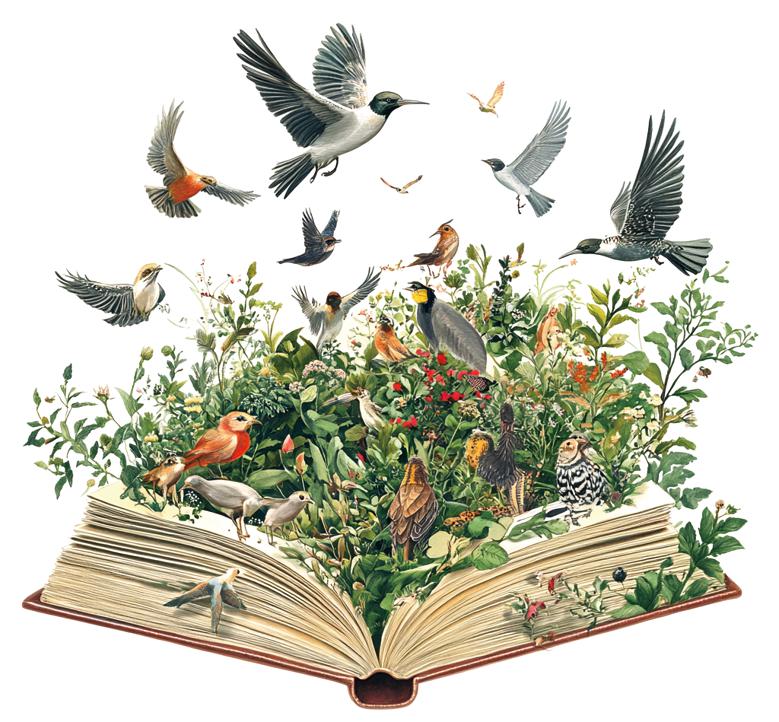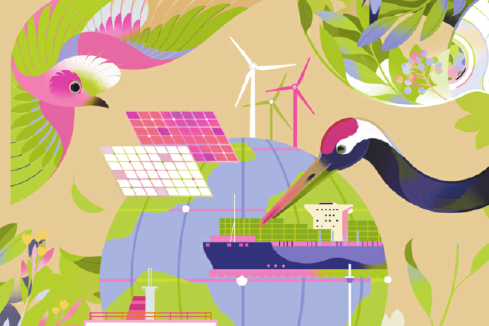Untangling threats to wild birds
China's efforts to deploy legal system to protect migratory birds paying off


Imagine a bird that can fit comfortably in the palm of your hand, flying thousands of kilometers from non-breeding grounds in the southern hemisphere to breeding grounds in China, Mongolia or Russia, navigating bad weather, evading predators and finding suitable stopover sites to rest and refuel only to end up caught in a mist net and a prolonged and painful death.
Unfortunately, this still happens to countless migratory birds every year. Some are trapped deliberately by poachers for the cage bird trade or for exotic food, while others are "by-catch" caught up in nets that are used by farmers to protect their crops or aquaculture.
Four of the planet's nine major bird migration flyways intersect in China and, every spring, billions of birds migrate north to take advantage of the explosion of insects in the northern summer, allowing them to have more offspring more quickly than if they stayed further south. And of course in autumn, as winter's icy grip takes hold at northern latitudes, the vast majority of these birds must head south. So, twice a year, it is "rush hour" on these bird expressways. These awe-inspiring journeys are some of the most remarkable natural spectacles and most of these migratory birds are shared by multiple countries from as far north as Siberia in Russia and Alaska in the United States to as far south as Australia and New Zealand, and even Africa.
In recent years, the legal system has been deployed to protect wildlife in China, including birds and their habitats. Major improvements in legislation have been made, such as the revised Wildlife Protection Law (revised in 2022) and the new Wetland Conservation Law (adopted in 2021). Notably, protection of migration routes of migratory birds and other wildlife is explicitly stipulated in the draft environmental code, which was submitted to the country's top legislature for first reading last month and will combine over 30 laws into a single overarching framework. These actions underpin China's commitment to effective implementation of the Kunming-Montreal Global Biodiversity Framework, which was agreed by more than 190 countries under China's presidency of the United Nations Convention on Biological Diversity in late 2022.
However, even if the laws are good on paper, a bird can't call the police or go to court if it is in trouble. This is the same all around the world, and poses a challenge to the effective enforcement of environmental laws.
In response, China has developed innovative systems to ensure these laws are being implemented effectively. Beyond clarifying the duties of government agencies at all levels, procuratorates and qualified nongovernmental organization have been empowered to bring public interest cases to protect the environment. This system has proved to be remarkably effective, with tens of thousands of legal challenges being brought every year.
China's legal work to protect birds really took off in 2023, following a side event at the World Coastal Forum in Yancheng, East China's Jiangsu province. Senior prosecutors from the procuratorates from all coastal provinces attended, and met with bird conservation specialists. The conclusion was clear: the use of illegal bird killing mist nets must be controlled, to avoid huge numbers of unnecessary bird deaths, and prevent endangered bird species from going extinct.
Procuratorates at all levels quickly started a comprehensive campaign to tackle mist nets. They engaged with companies producing the nets, as well as e-commerce companies and local government agencies in farming communities. They also initiated public education programs and encouraged the use of alternative bird deterrents. Ornithologists have even been brought together to research a standard for legal nets. Such a standard would enable a clear ban on mist nets, the tool of choice of poachers. At the same time, it would define the types of nets which are visible to birds, and which farmers can use to protect their crops.
This demonstrates China's unique ability to convene a range of stakeholders to address important and complex environmental issues.
This approach has since been applauded by world-leading conservation experts. Martin Harper, CEO of Birdlife International, the world's largest conservation partnership, has commented that this work has the potential to bend the curve of migratory bird population declines in the East Asian-Australasian Flyway, the most threatened flyway in the world.
China's environmental NGOs have also successfully brought powerful cases for bird conservation. For example, in October 2024, Friends of Nature brought a case against Kuaishou, a popular short video platform, for allegedly allowing people to advertise and sell illegal hunting equipment, including mist nets, on their platform. In 2023, the same NGO partnered with others in a case which led to a court order to halt a coastal development in Lianyungang, Jiangsu province, which would have destroyed a globally important intertidal mudflat.
These initiatives are making a difference. Both the production and the sales of mist nets on e-commerce platforms have significantly decreased, and warning signs appear when you search for them. Poachers are being deterred from intentionally killing birds through public outreach programs and greater public awareness. Farmers of aquaculture products and crops are exploring and adopting alternative ways to protect their crops without killing birds, for example by using reflective materials that flutter in the wind, kites in the shape of predators such as hawks and acoustic devices.
If Chinese authorities are successful in developing a standard for "anti-bird nets" that allows farmers to protect their crops, it would pave the way for a ban on the public sale of nets that do not meet the standard, pulling the rug from under the poachers. At the same time, many wild birds are killed by mist nets in Southeast Asia, so a standard has the potential to be adopted more widely, potentially saving millions more migratory birds in the region and strengthening China's environmental reputation overseas.
If there is one thing we have learned from nature, it is that it is incredibly resilient. Given the chance, species can bounce back.
There are perhaps two species that are particularly vulnerable and that have suffered through the use of mist nets — the Spoon-billed Sandpiper and the Yellow-breasted Bunting, both now classified as critically endangered, just one step away from extinction. Halting the widespread use of mist nets would remove one of the biggest threats to these two species, providing a huge boost to their survival chances. Wouldn't it be incredible if we could witness recoveries in the population of these two species?
China's procuratorates, civil society, government agencies and public are making tremendous progress in tackling the problem of bird-killing mist nets. This effort should be actively continued, as it is set to be a game changer for migratory birds along the Asian flyways, It may also provide valuable experience which could benefit other countries in the region, as they step up their efforts to protect birds and habitats.


Dimitri de Boer is director for China at ClientEarth and special adviser of the China Council for International Cooperation on Environment and Development. Terry Townshend is an adviser to the Paulson Institute. The authors contributed this article to China Watch, a think tank powered by China Daily. The views do not necessarily reflect those of China Daily.
Contact the editor at editor@chinawatch.cn.
































